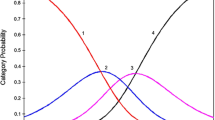Abstract
The AQ (Autism-Spectrum Quotient) is a self-administered instrument for measuring the degree to which an adult with normal intelligence has the traits associated with the autistic spectrum. The AQ was administered in Japan to test whether the UK results would generalize to a very different culture. Three groups of subjects, adults with AS or HFA (n=57), adult controls (n=194), and University students (n=1050) were assessed. The adults with AS/HFA had a mean AQ score which was significantly higher than both the controls and the University students. Among the controls, males scored significantly higher than females. The similarity of results in both the general population and the clinical group across the two cultures was remarkable.
Similar content being viewed by others
References
APA. (1994). DSM-IV diagnostic and statistical manual of mental disorders, 4th Edition. American Psychiatric Association, Washington, DC
Bailey T., Le Couteur A., Gottesman I., Bolton P., Simonoff E., Yuzda E., Rutter M., (1995). Autism as a strongly genetic disorder: Evidence from a British twin study Psychological Medicine 25: 63–77
Baron-Cohen S., (1995). Mindblindness: An essay on autism and theory of mind. MIT Press/Bradford Books, Boston
Baron-Cohen, S. (2002). The extreme male brain theory of autism. Trends in Cognitive Sciences, 6, 248–254
Baron-Cohen S., (2003). The essential difference: Men, women and the extreme male brain. Penguin, London
Baron-Cohen, S., & Hammer, J. (1997). Is autism an extreme form of the male brain? Advances in Infancy Research, 11, 193–217
Baron-Cohen, S., Hoekstra, R., Knickmeyer, R., & Wheelwright, S. (submitted). The Autism-Spectrum Quotient (AQ) – children’s version
Baron-Cohen S., Richler J., Bisarya D., Gurunathan N., Wheelwright S., (2003). The Systemising Quotient (SQ): An investigation of adults with Asperger syndrome or high functioning autism and normal sex differences Philosophical Transactions of the Royal Society, Series B, Special issue on “Autism: Mind and Brain” 358: 361–374
Baron-Cohen S., Wheelwright S., Skinner R., Martin J., Clubley E., (2001). The Autism Spectrum Quotient (AQ): Evidence from Asperger syndrome/high functioning autism, males and females, scientists and mathematicians Journal of Autism and Developmental Disorders 31: 5–17
Frith U., (1991). Autism and Asperger’s syndrome. Cambridge University Press, Cambridge
Rutter, M. (1978). Language disorder and infantile autism. In M. Rutter & E. Shopler (Eds.), Autism: A reappraisal of concepts and treatment. New York: Plenum Press
Wing L., (1981). Asperger syndrome: A clinical account Psychological Medicine 11: 115–130
Wing L., (1988). The autistic continuum. In Wing L., (Ed.), Aspects of autism: Biological research. Gaskell/Royal College of Psychiatrists, London
Wing, L., & Gould, J. (1979). Severe impairments of social interaction and associated abnormalities in children: Epidemiology and classification. Journal of Autism and Developmental Disorders, 9, 11–29
World Health Organization (1992). International classification of diseases (10th ed.). World Health Organisation, Geneva, Switzerland
Acknowledgments
SBC and SW were supported by a grant from the MRC during the period of this work. We are grateful to the individuals with high-functioning autism and Asperger Syndrome and their parents for their participation. Finally, we thank Professors K Narita, S Tsukamoto, H Yamada, and Mr. A Senju for their help with data collection.
Author information
Authors and Affiliations
Corresponding author
Rights and permissions
About this article
Cite this article
Wakabayashi, A., Baron-Cohen, S., Wheelwright, S. et al. The Autism-Spectrum Quotient (AQ) in Japan: A Cross-Cultural Comparison. J Autism Dev Disord 36, 263–270 (2006). https://doi.org/10.1007/s10803-005-0061-2
Published:
Issue Date:
DOI: https://doi.org/10.1007/s10803-005-0061-2




